Hennepin County, Minnesota
Sphingidae
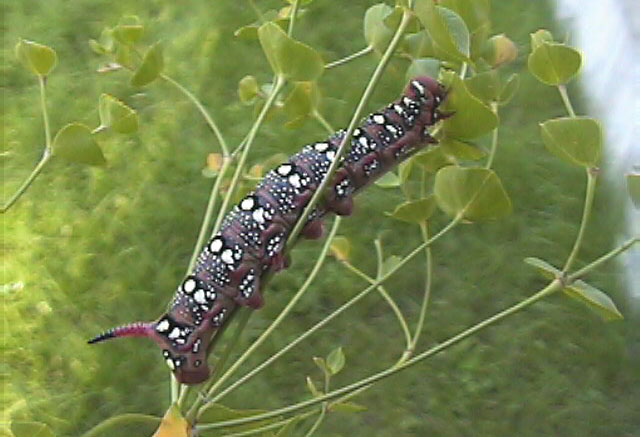
Hyles euphorbiae, Minneapolis, Minnesota, courtesy of Mark Black.

Hyles euphorbiae, Minneapolis, Minnesota, courtesy of Mark Black.
|
|
Created/dedicated as per personal communication with Mark Black, September 2005 Updated as per James P. Tuttle's The Hawk Moths of North America, August, 2009 Updated with Hemaris diffinis confirmed by Eric Foss, August, 2009 Updated as per personal communication with Erik Stahl, May 29, 2012 |

Hyles euphorbiae, Minneapolis, Minnesota, courtesy of Mark Black.
Mark writes, September 19, 2005,
"Hi Bill,
"I thought I'd let you know that I found a number of spurge hawkmoth caterpillars - Hyles euphorbiae, here in Minneapolis. They are the most beautiful caterpillars that I've even seen in person! Your site and bugguide.net helped me identify them. I took a few home and they've already pupated. I'll send you some photos. Keep up the great work on the web!!!
"I can confirm the Blinded sphinx. A friend brought me a caterpillar a couple years ago and we raised it to adulthood. My girlfriend found a Waved sphinx in a parking ramp in downtown Minneapolis a couple years ago."
Twelve Sphingidae species are listed for Minnesota on the U.S.G.S. website. Not all of the species are reported or anticipated in Hennepin County (only one, Sphinx chersis is reported on U.S.G.S.). It is hoped that this checklist, with the thumbnails and notes, will help you quickly identify the moths you are likely to encounter.A "WO" after the species name indicates that I have no confirmed reports of this species in your county, but I (William Oehlke) expect that this moth is present or might be present. I have included many species not on the USGS list for Minnesota; I believe they are or might be present. Many, that are not on the USGS list, have been confirmed by Tom Middagh for Minnesota. Hyles lineata larva on primrose, Hennepin County, courtesy Theresa Baker, photo credit Ari Greenmen. | 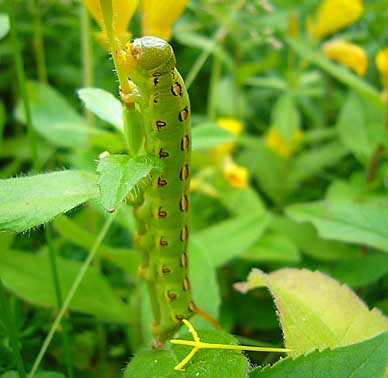 |
Many thanks also to Erik Stahl who sends the following images and interesting note:
"I have had numerous sightings of large moths in my yard and while trying to identify them I eventually found my way to a website that listed your name as a good
contact.
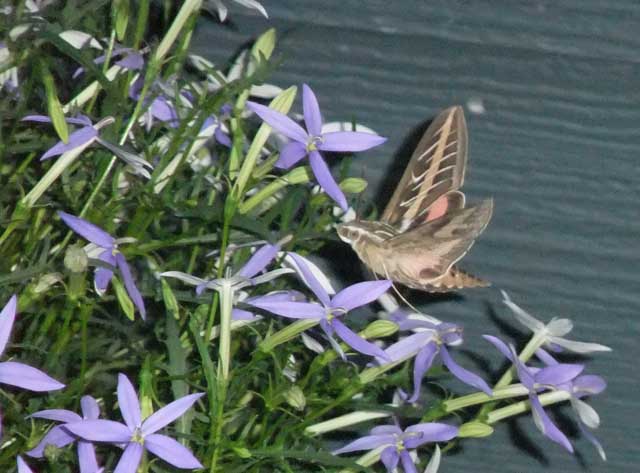
Hyles lineata, Saint Louis Park, Hennepin County, Minnesota,
May 28, 2012, courtesy of Erik Stahl.
"From the pictures at this site, I'm pretty sure that the moths visiting my yard are White-Lined Sphinx. I live in Saint Louis Park, Minnesota (Hennepin County), and the website seems to indicate that these have been seen by others in my area. If you could confirm this from the attached photo, I'd be extremely appreciative to have an expert confirmation.
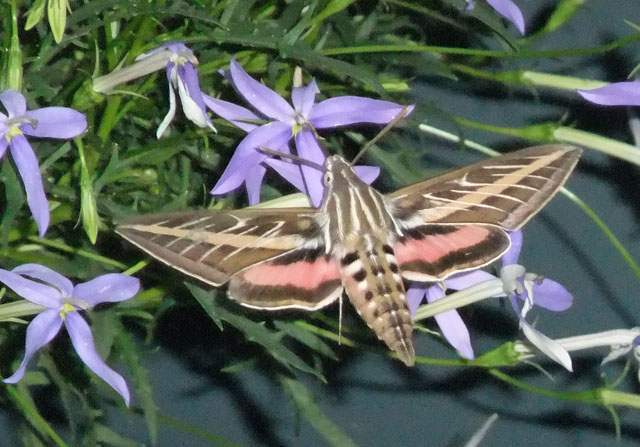
Hyles lineata, Saint Louis Park, Hennepin County, Minnesota,
May 28, 2012, courtesy of Erik Stahl.
"I'm also a gardener and one of my favorite plants/flowers is Laurentia. Only a small number of the garden stores here carry it so it isn't the most common plant, but I always get wonderful compliments about it and many people who walk by my yard ask me what it is. It blooms all summer long and at the end of the summer it doesn't look that much different from how it looks right now. What I've discovered is that Laurentia seems to be a major attractant for these moths. During the day, I rarely see any bees, flies, butterflies, or other pollinators showing any interest in it at all. However, right at dusk, I've been noticing that these moths come to visit the Laurentia. When I first put the Laurentia pots out this year a couple weeks ago, there was one moth who would come visit every night. Tonight I had four of these moths visiting these pots at the same time. I watched (and took photos) as they went from flower to flower, and all four of them were there for over twenty minutes before flying away.
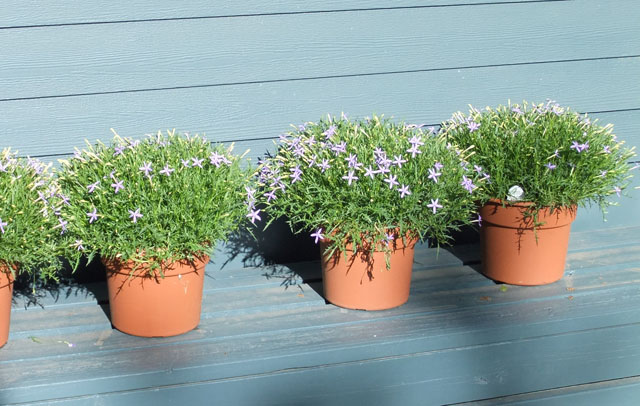
Laurentia pots, Saint Louis Park, Hennepin County, Minnesota,
courtesy of Erik Stahl.
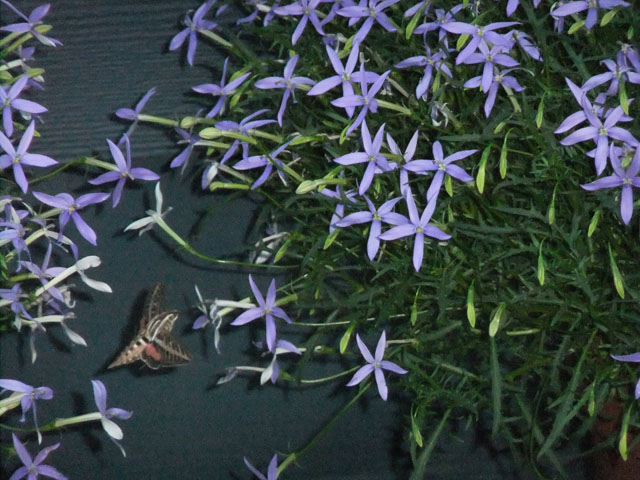
Laurentia and guest, Saint Louis Park, Hennepin County, Minnesota,
courtesy of Erik Stahl.
A "USGS (Now BAMONA) indicates the moth is reported in Lepidoptera of North America, #1. Distribution of Silkmoths (Saturniidae) and Hawkmoths (Sphingidae) of Eastern North America, an excellent little booklet available through Paul Opler. Please also forward sightings to BAMONA.
Please help me develop this list with improved, documented accuracy by sending sightings (species, date, location), preferably with an electronic image, via email to Bill Oehlke.
Sphinginae subfamily
Smerinthini Tribe:
Macroglossinae subfamilyDilophonotini tribe:
Philampelini tribe:
Macroglossini tribe:
|
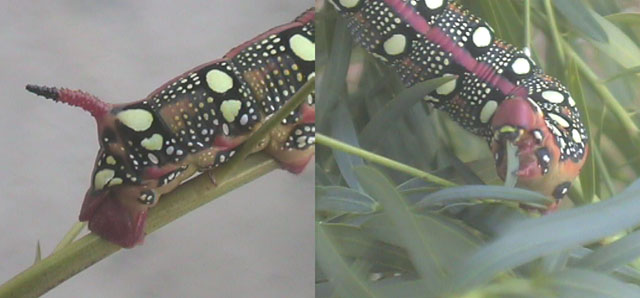
Hyles euphorbiae tail and head, courtesy of Mark Black, Minneapolis, Minnesota.
Enjoy some of nature's wonderments, giant silk moth cocoons. These cocoons are for sale winter and fall. Beautiful Saturniidae moths will emerge the following spring and summer. Read Actias luna rearing article. Additional online help available.
Eggs of many North American species are offered during the spring and summer. Occasionally summer Actias luna and summer Antheraea polyphemus cocoons are available. Shipping to US destinations is done from with in the US.
Use your browser "Back" button to return to the previous page.
This page is brought to you by Bill Oehlke and the WLSS. Pages are on space rented from Bizland. If you would like to become a "Patron of the Sphingidae Site", contact Bill.
Please send sightings/images to Bill. I will do my best to respond to requests for identification help.
 Show appreciation for this site by clicking on flashing butterfly to the left. The link will take you to a page with links to many insect sites. |